We often track where smart money managers invest. But seldom do we attach the same level of importance when promoters buy their company shares. Undeniably, monitoring promoter stake changes closely can give us vital clues to the future of a company. Hiking stakes is definite positive as it is a show of confidence in the company’s future. Behind such decisions could also be something good on the way for the company, something that the market is still not aware of. And then, if promoters see value at a particular price level, who is to say it is not a good entry point into the stock. In most cases, it may just be a trading decision to take advantage of a temporary slump in stock prices. For instance, several promoters hiked their stake in March 2009 quarter to take advantage of decimated stock prices. Even as most investors felt left out of the rally, several promoters made a killing for themselves. Some promoters also used the downturn to increase their stake, so that they could pledge their shares to fund future capital needs. The promoters of UTV Software increased their stake from 60 per cent levels in the September 2008 quarter to around 83.25 per cent in the December 2008 quarter. So, while the promoters’ shares increased by 71 lakh, they also pledged around 78 lakh shares (23 per cent of the company) in February 2009. Had the promoters decided to make the purchase in the first quarter of 2008, they would have had to shell out Rs 639 crore. But they got it all for roughly Rs 145 crore in the December quarter when the share price tanked to Rs 210 levels. Currently, the share is hovering around Rs 474.
Yet not all stake hikes mean good times are ahead. Over the years, promoters have found innovative ways to maximise returns by selling shares in the open market at higher prices and buying back into the company through preferential allotments. So you got to be watchful of the motives. You also have to look at whether the promoters are hiking their stake with the intention to delist shares. Most companies in India that have gone in for delisting, so far, haven’t always kept shareholders’ interest in mind. In fact, some companies have notoriously gone ahead and made offer for delisting at opportune time when shares prices were at a low. Though the Securities and Exchange Board of India has tightened delisting norms by insisting that the offer price be higher of the 26-week average or the two-week average preceding the notification date, in a bearish environment it could still result in a raw deal for shareholders.
Apart from short-changing shareholders using the delisting norm, the problem also arises when promoters use the access to company’s information or future prospects to maximise their returns by exiting much ahead of the market. More often than not, they seem to have valid reasons and manage to allay investor concerns regarding a stake sale almost immediately with their PR machinery in full flow. It is often in hindsight that pieces of the puzzle are put together. For instance, before the disruptive pricing strategies of telecom operators brought about a series of downgrades in the telecom operator, Bharti Airtel managing director Manoj Kholi sold his stake in the company months before the whole pricing ruckus started. Yes, it may have been for a house he wanted to buy, but who better than him (although he is not the promoter) to have had an inkling of the times to come for the telecom sector. So the question we need to ask is whether we should put our faith in companies when promoters themselves have very little faith?
Against such a backdrop, we have shortlisted five buys and five sells based on changes in promoter holdings over the past eight quarters, the company’s fundamentals and its growth potential. While promoter stake changes cannot be the only yardstick for investment decisions, it is definitely one of the most important parameters investors need to keep track of before investing in a stock.
Apollo Hospitals
- LTP (Rs): 570 (as on Dec 22, 2009)
- YTD returns (%): 26
- Promoter holding (%): 33.51 (as on Sept 2009)
Apollo Hospitals has moved in tandem with the benchmark, delivering 12 per cent returns against 7 per cent for the Sensex
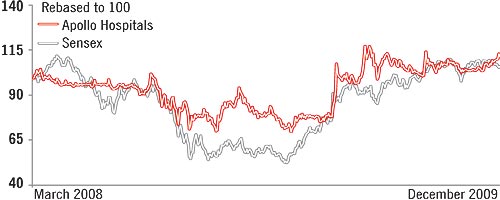
Source: Bloomberg
***
With a population of over a billion people, rising income levels, changing demographics and illness profiles (a shift from chronic to lifestyle diseases), the $35 billion Indian healthcare industry is forecast to double in value by 2012 and more than quadruple by 2017. The Chennai-based Apollo Hospitals, which boasts one of the largest hospital networks in Asia, is best placed to take advantage of this healthcare boom. To capitalise on the burgeoning opportunities, the company has drawn up aggressive expansion plans. Apollo currently owns 4,620 beds and manages another 3,100 beds, giving it 7,720 beds under its brand. By the end of three years, it plans to take that figure to 10,220. Analysts say that it scores above most of its competitors on scale, brand recognition and service offerings. The company is targeting a growth of 25-30 per cent (y-o-y) in the next couple of years. No one seems more convinced about the company’s prospects than the promoters themselves, who have hiked their stake from 27.47 per cent in June 2008 to 33.51 per cent in September 2009. In fact, such is the confidence in the intrinsic value of the business that chairman Pratap C Reddy opted to hike his stake by converting his share warrants into equity (15.94 lakh shares, nearly 2 per cent of the company’s paid-up capital). The warrants were issued at Rs 497.69 per share in April 2009 (at an almost 25 per cent premium over the prevailing stock price). The healthcare business which enjoys a highly predictable and stable earnings stream is seen as a recession-proof business. The stock which trades at 22 times 2010 earnings, has managed to outperform the market during the downturn. Given its growth prospects and expansion plans, the stock is likely to do well in the future.
Hexaware Technologies
- LTP (Rs): 97
- YTD returns (%): 358
- Promoter holding (%): 28.65
Despite the downturn, billing rates remain firm due to improved services mix
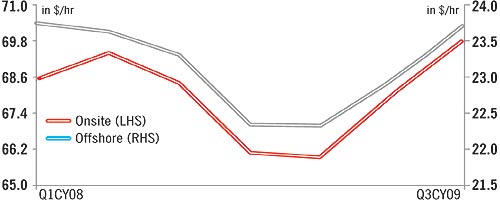
Source: Company, Edelweiss research
***
It’s been a bit of roller-coaster ride for this Mumbai-based technology company in the past few years. In 2007, losses on some exotic derivatives burnt a huge hole in its profits and caused a large sell-off in the stock. Even as it struggled to recover from the financial debacle, the global financial crisis struck, ripping revenue growth apart. Then followed an exodus of some from the top management team. But to its credit, all these are now just memories. A new management, focused on improving revenues and profitability, is making its mark. In the September-ended quarter, Hexaware won orders worth $80 million (around Rs 350 crore). Even more impressive, it also managed to improve on its billing rates in the past 2-3 quarters, when nearly every tech firm was experiencing pricing pressures. It also managed to control operating costs effectively leading to a substantial improvement in margins, which jumped to 23.7 per cent in the quarter from 13.3 per cent in the corresponding quarter a year ago. Analysts expect the company to post a jump of up to 76 per cent in profits in 2009 and what’s more, the promoters have been increasing their stake in the company from 23.58 per cent in December 2008 to 28.65 per cent in September 2009. Its healthy cash reserves of over Rs 400 crore (30 per cent of its market capitalisation) provides strong valuation support. Analysts expect the stock, which trades at 10 times its estimated 2010 earnings, to outperform its peers with growth rates expected to perk up in the next couple of years.
Jagaran Prakashan
- LTP (Rs): 128
- YTD returns (%): 114
- Promoter holding (%): 55.33
In a turbulent FY09, when the media industry was in doldrums, JPL’s ad revenues grew by 11 per cent
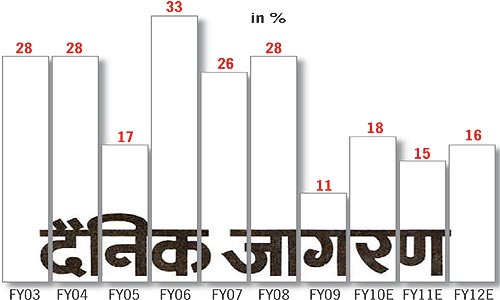
***
The Kanpur-based publishing house has a lot going for it With a readership of 55 million, the company’s flagship Hindi newspaper, Dainik Jagran, continues to be the largest read daily of India. Besides, Dainik Jagran is also the No. 1 read daily among people who can read English, according to the Indian Readership Survey. With 37 editions and 150 plus sub-editions (apart from the main editions), Dainik Jagran covers 11 states – that is nearly 60 per cent of the country’s population. More importantly, Jagran Prakashan’s (JPL’s) business model has enabled it to consistently deliver a positive ad revenue growth over the past seven years. In fact, in a turbulent FY09 when the media industry was in the doldrums, JPL’s ad revenues grew 11 per cent. The reason: more than 44 per cent of all one million-plus populated cities and 42 per cent of all one lakh-plus towns in India fall within Jagran markets.
And with advertisers shifting focus from metros to non-metro and rural areas, JPL has capitalised on its reach well. Not surprising then that the share of local advertising revenues (as a percentage of total ad revenues) is around 63 per cent, against 45 per cent three years back. Besides, JPL is looking at increasing the sale of color ad space as it comes at 25-50 per cent premium to black and white rates. In fact, colour ads, as a percentage of total ad space, has increased from 19 per cent in FY05 to 40 per cent in FY09. Further, unlike English dailies, Hindi newspapers have a higher share of circulation revenues and have the pricing advantage in their hands. A case in point is that during the recent slowdown, JPL hiked its cover price by around Rs 0.50 for nearly 50 per cent of its editions in December 2008. “Hence, circulation revenues will support the top line even during a slowdown when ad revenues are declining,” says Abneesh Roy of Edelweiss, which has a buy rating on JPL, with a target price of Rs 150. Also, given that the states in which Jagran operates have lower literacy rates, there exists the potential for higher growth in circulation numbers. Analysts expect JPL’s earnings to grow annually by 39 per cent over FY09-FY12. More importantly, in a move that reposes faith in the management, the promoters increased their holding by 3.2 per cent in the current fiscal to 55.33 per cent at around Rs 69 levels, after consistently maintaining their stake at 52 per cent for the last three years. At 19 times estimated FY11 earnings of Rs 6.6, the stock is quoting well below its three-year average of around 22 times one-year forward earnings.
Pantaloon
- LTP (Rs): 364
- YTD returns (%): 67
- Promoter holding (%): 48.79
The Big Bazaar hive-off will transform PRIL into a pure retail play and allow investors direct exposure to pure discount retailing when Big Bazaar gets listed
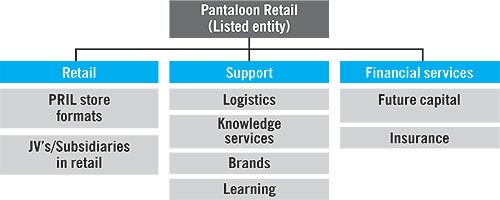
Source: Company, IIFL research
***
The Future group-owned retail chain operator is restructuring its business which would entail, first, a consolidation of Pantaloon Retail India (PRIL) as a pure retail play and transfer of the Big Bazaar and Food Bazaar formats (accounting for 70 per cent of standalone revenues) into wholly-owned subsidiaries of PRIL; second, transferring all non-retail businesses into a separate company and, third, unlocking value in the financial services businesses. According to analysts, the Big Bazaar hive-off will allow investors a direct exposure to pure discount retailing if and when Big Bazaar gets listed. Meanwhile, Pantaloon’s stake in Future Capital (55 per cent) and the insurance business (49.7 per cent) will be demerged into a separate holding company in which it will hold a controlling 26 per cent stake, and shareholders of Pantaloon will hold the balance. However, the market does not expect the financial services arm to be listed for another two years. Further, the transfer of the non-retail business of Pantaloon (Future Knowledge, Future Brands, Future Learning & development) to a promoter group company, means no additional investments have to be made by PRIL. Pantaloon Retail, which plans to keep adding 2.3 million square feet retail space every year, is looking to invest Rs 360 crore this fiscal for its retail space expansion. Besides, PRIL, which derives 30 per cent of revenues from its private labels, is expected to launch its own branded cereals and is looking at buying a foods-focused FMCG company. With Rs 900 crore in cash profit generation, Rs 500 crore raised through a QIP and rightsizing the business, analysts believe PRIL is well placed to deleverage its balance sheet. Post restructuring, Pantaloon’s debt-equity ratio of 1:1.2 (current debt is Rs 300 crores) will fall to 1:0.8. The promoters have steadily increased their stake from 42 per cent in FY07 to around 49 per cent in the current fiscal. The stock, which has outperformed the Sensex by 54 per cent in the current fiscal, is currently trading at 24 times estimated FY11 earnings. According to analysts, the possible induction of a foreign partner is one of the drivers for the Big Bazaar hive-off and that should be enough to keep the counter buzzing in the near term.
Shriram Transport
- LTP (Rs): 440
- YTD returns (%): 126
- Promoter holding (%): 44.12
Better management of cash and securitisation income to drive margins
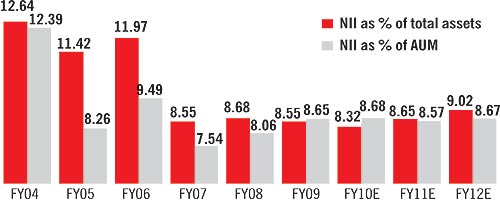
Source: JM Financials
***
After being in the business for almost three decades, the country’s largest commercial vehicle financing company has created a strong entry barrier for other non-banking finance companies and banks. The Chennai-based Shriram group’s flagship company has developed strong expertise in credit evaluation, it boasts a relationship-based approach (0.6 million customers), and an extensive branch network (482), all of which are difficult to replicate. Though growth in assets under management (loan book and securitised assets put together) slowed down to 19 per cent last fiscal owing to the economic slowdown, analysts sense a turnaround. With a revival in industrial production, trucks sold over FY04-07 coming up for refinancing by FY12 and improving credit availability, analysts are making a case for a re-rating. Further, the non-banking finance company has successfully diversified its funding mix away from retail loans to wholesale funds such as bank loans, which constitute 60 per cent of its borrowings against 9 per cent in FY03. Importantly, 50 per cent of the NBFC’s borrowings are at fixed rates, which will act as a cushion as interest rates gradually rise. Though Shriram enjoys lucrative net interest margins of 8 per cent, it has managed to contain bad loans at 2.3 per cent of total assets owing to conservative lending practices. In the last five years, Shriram’s loan on books grew by 85 per cent CAGR, while the securitised loan portfolio grew by 42 per cent CAGR over the same period. Going ahead, analysts expect a 24 per cent annual growth in its AUM over FY09-12. Besides, the market believes the NBFC’s steady high-twenties return on equity supports a valuation of 3.3x current fiscal price-to-book value. What should also warm the cockles of investors’ hearts is that promoters have been steadily increasing their stake from 26.11 per cent in FY06 to 44.12 per cent as of September 2009.
***
Changing contours
Promoter stake purchases and sales have been aplenty in 2009. Here are the top 25 positive and negative changes in holdings, including opens offers, change in managements and preferential allotments
| Company | Promoters holding (%) | Change in holding |
| | Mar07 | Mar08 | Jun08 | Sep08 | Dec08 | Mar09 | Jun09 | Sep09 |
| U T V Software | 30.68 | 32.54 | 60.6 | 60.6 | 83.25 | 83.25 | 83.25 | 83.25 | 50.71 |
| Essar Shipping | 47.25 | 47.25 | 47.25 | 47.25 | 47.25 | 83.71 | 83.71 | 83.71 | 36.46 |
| Era Infra Engg. | 23.71 | 24.23 | 43.56 | 44.07 | 58.38 | 58.17 | 58.11 | 58.11 | 33.88 |
| Zandu Pharma | 41.99 | 41.99 | 20.19 | 20.39 | 72.8 | 72.8 | 72.8 | 72.8 | 30.81 |
| Pfizer | 41.23 | 41.23 | 41.23 | 41.23 | 41.23 | 41.23 | 41.23 | 70.75 | 29.52 |
| Ranbaxy Labs | 34.83 | 34.82 | 34.81 | 34.74 | 63.92 | 63.92 | 63.92 | 63.92 | 29.1 |
| Novartis India | 50.93 | 50.93 | 50.93 | 50.93 | 50.93 | 50.93 | 76.42 | 76.42 | 25.49 |
| Fresenius Kabi | 65.3 | 65.3 | 65.29 | 90.89 | 90.89 | 90 | 90 | 90 | 24.7 |
| Thomas Cook | 61.78 | 54.42 | 55.82 | 74.89 | 74.89 | 77.31 | 77.31 | 77.31 | 22.89 |
| Sunteck Realty | 43.45 | 48.34 | 48.34 | 52.27 | 68.43 | 68.43 | 68.43 | 68.54 | 20.2 |
| Hindustan Oil Exploration | 27.16 | 27.17 | 27.17 | 47.18 | 47.18 | 47.18 | 47.18 | 47.18 | 20.01 |
| Indo Tech Transformers | 54.35 | 54.35 | 54.35 | 54.35 | 54.35 | 54.35 | 74.35 | 74.35 | 20 |
| HSBC Investdirect | 73.21 | 73.21 | 73.21 | 93.86 | 93.86 | 93.86 | 93.86 | 93.11 | 19.9 |
| BASF India | 52.69 | 52.69 | 52.69 | 71.18 | 71.18 | 71.18 | 71.18 | 71.18 | 18.49 |
| Madhucon Projects | 40.77 | 40.77 | 40.77 | 52.29 | 56.56 | 57.27 | 57.66 | 57.66 | 16.89 |
| BOC India | 54.8 | 73.99 | 73.99 | 89.48 | 89.48 | 89.48 | 89.48 | 89.48 | 15.49 |
| Dish T V India | 57.94 | 57.94 | 57.94 | 57.94 | 57.94 | 80.15 | 72.83 | 72.83 | 14.89 |
| BF Utilities | 48.5 | 52.28 | 65.98 | 65.98 | 65.98 | 66.09 | 66.11 | 66.11 | 13.83 |
| Alfa Laval | 76.73 | 76.73 | 76.73 | 76.73 | 76.73 | 88.77 | 88.77 | 88.77 | 12.04 |
| Tata Teleservices | 65.77 | 65.77 | 65.64 | 65.64 | 65.64 | 65.64 | 77.75 | 77.72 | 11.95 |
| Heidelberg Cement | 60.22 | 59.23 | 59.23 | 54.89 | 54.89 | 68.55 | 68.55 | 68.55 | 9.32 |
| Tata Motors | 33.42 | 33.42 | 33.4 | 33.34 | 41.78 | 41.73 | 41.38 | 40.62 | 7.2 |
| Man Industries | 40.54 | 40.62 | 43.86 | 44.74 | 46 | 47.07 | 47.84 | 47.52 | 6.9 |
| S Kumars | 44.51 | 43.51 | 44.82 | 46.89 | 46.89 | 46.89 | 49.83 | 49.83 | 6.32 |
| Apollo Hospitals | 27.47 | 27.47 | 27.47 | 31.57 | 31.7 | 31.76 | 33.51 | 33.51 | 6.04 |
| Tata Investment | 60.61 | 60.64 | 60.64 | 60.64 | 60.64 | 61.02 | 61.02 | 66.67 | 6.03 |
| Sesa Goa | 51.18 | 51.18 | 51.18 | 51.18 | 51.18 | 51.18 | 53.1 | 57.12 | 5.94 |
| GTL | 34.4 | 38.19 | 44.14 | 44.14 | 44.14 | 44.08 | 44.08 | 43.92 | 5.73 |
| Maharashtra Seamless | 42.88 | 46.22 | 46.26 | 46.26 | 49.97 | 51.09 | 51.44 | 51.54 | 5.32 |
| Simplex Infra | 45.33 | 49.42 | 49.42 | 49.42 | 49.42 | 54.09 | 54.09 | 54.74 | 5.32 |
| Unitech | 74.56 | 74.56 | 74.56 | 74.56 | 67.46 | 64.52 | 51.23 | 43.84 | -30.72 |
| Sobha Developers | 86.99 | 87 | 87 | 87 | 87 | 87 | 87 | 64.67 | -22.33 |
| Orbit Corporation | 60.49 | 60.47 | 60.49 | 60.49 | 60.49 | 60.49 | 60.49 | 42.03 | -18.44 |
| Golden Tobacco | 45.42 | 45.42 | 38.31 | 37.36 | 36.11 | 27.17 | 27.17 | 27.19 | -18.23 |
| Maytas Infra | 36.64 | 36.64 | 36.64 | 36.64 | 36.64 | 35.23 | 35.23 | 21.5 | -15.14 |
| Housing Devlop. & Infra | 61.5 | 61.5 | 61.5 | 61.5 | 61.5 | 61.5 | 60.7 | 48.35 | -13.15 |
| Suzlon Energy | 65.91 | 65.89 | 65.89 | 65.83 | 65.83 | 65.83 | 59.82 | 53.08 | -12.81 |
| UCO Bank | 74.98 | 74.98 | 74.98 | 74.98 | 63.59 | 63.59 | 63.59 | 63.59 | -11.39 |
| Indiabulls Real Estate | 27.14 | 27.87 | 26.06 | 26.06 | 26.06 | 26.06 | 16.73 | 16.72 | -11.15 |
| Bartronics India | 40.29 | 38.94 | 37.3 | 33.22 | 33.19 | 31.03 | 29.43 | 27.95 | -10.99 |
| Sterlite Industries (India) | 62.47 | 62.47 | 62.47 | 60.63 | 60.99 | 61.19 | 61.71 | 52.02 | -10.45 |
| 3i Infotech | 39.6 | 39.55 | 39.52 | 39.49 | 39.49 | 39.49 | 39.46 | 29.97 | -9.58 |
| DLF | 88.17 | 88.16 | 88.16 | 88.15 | 88.26 | 88.55 | 78.65 | 78.65 | -9.51 |
| Bharat Petroleum Corp | 64.26 | 64.26 | 64.26 | 64.26 | 64.26 | 64.26 | 54.93 | 54.93 | -9.33 |
| Allied Digital Services | 64.81 | 64.81 | 64.58 | 63.66 | 61.18 | 60.82 | 55.72 | 55.59 | -9.22 |
| PSL | 48.36 | 48.36 | 48.38 | 48.38 | 48.85 | 49.13 | 49.13 | 39.25 | -9.11 |
| Indage Vintners | 35.67 | 33.36 | 39.61 | 39.61 | 28.54 | 28.08 | 25.42 | 24.62 | -8.74 |
| Idea Cellular | 57.69 | 57.69 | 57.69 | 49.05 | 49.13 | 49.13 | 49.13 | 49.05 | -8.64 |
| Bajaj Hindusthan | 45.55 | 45.65 | 45.65 | 45.65 | 45.65 | 46.42 | 46.42 | 37.07 | -8.58 |
| Ackruti City | 89.96 | 89.96 | 89.96 | 89.96 | 89.96 | 89.96 | 89.96 | 82.49 | -7.47 |
| IBN 18 Broadcast | 59.22 | 59.22 | 57 | 54.86 | 51.02 | 54.8 | 52.01 | 52.01 | -7.21 |
| Punj Lloyd | 45.01 | 44.65 | 44.48 | 44.37 | 44.25 | 41.47 | 41.26 | 37.52 | -7.13 |
| Hindustan Cons. Co. | 46.96 | 46.96 | 46.96 | 47.17 | 47.17 | 47.17 | 47.17 | 39.86 | -7.1 |
| GVK Power & Infrastructure | 60.94 | 60.94 | 60.94 | 60.94 | 60.94 | 60.94 | 60.94 | 54.25 | -6.69 |
| Indusind Bank | 28.45 | 28.45 | 25.63 | 25.63 | 25.63 | 25.63 | 25.63 | 22.2 | -6.25 |
| Shree Renuka Sugars | 40.45 | 40.53 | 40.53 | 40.53 | 41.82 | 41.15 | 39.01 | 34.46 | -6.07 |
| Fortis Healthcare | 74.45 | 74.45 | 74.42 | 74.42 | 68.23 | 68.45 | 68.46 | 68.45 | -6 |
| Eicher Healthcare | 61.76 | 61.76 | 61.76 | 53.66 | 53.66 | 53.66 | 55.92 | 55.92 | -5.84 |
| Educomp Solutions | 56.07 | 56 | 55.04 | 55.04 | 55.03 | 55.02 | 54.93 | 50.21 | -5.79 |
| Lanco Infratech | 75 | 73.68 | 73.61 | 73.58 | 73.58 | 73.58 | 73.58 | 67.95 | -5.73 |
***
Bartronics
- LTP (Rs): 141
- YTD returns (%): 67
- Promoter holding (%): 27.95
The proportion of domestic market in total revenues has increased to two-thirds in recent times

Source: Company data, JRG Research
***
Bartronics offers automatic identification and data capture (AIDC) and radio-frequency identification (RFID) technology-related products and services, smart cards and point of sale (POS) solutions. This Hyderabad company has been on a high growth path for the past four years, growing by 100 per cent. It is currently targeting a 70-80 per cent growth in revenues for the next three years. Its order book stands at Rs 650 crore, executable over the coming 14 months. About Rs 500 crore comes from the RFID division, while the balance comes from the smart card division. Bartronics is betting big on government business, which constitute 5 per cent of its revenues in FY09. Once revenues from the Aapke Dwar project (a Delhi government project expected to bring in annual revenues of up to Rs 500 crore for Bartronics over a nine-year period) start to kick in, government-led project revenues will likely constitute more than half of the revenues after that. With such promising growth prospects, you would think that the promoters would hold on to their stake real tight, right? No, the promoters, in fact, have steadily reduced their stake from 40.29 per cent in December 2007 to 27.95 per cent in September this year. Worse, 9.17 per cent of those shares are pledged. With a significant debt load likely to come onto its books (debt is forecast to jump by Rs 600 crore in the next two years), its debt-equity ratio will rise to 1.10 in 2011. A dwindling promoter stake even against the backdrop of promising growth prospects also raises a red flag.
Educomp Solutions
- LTP (Rs): 705
- YTD returns (%): 47
- Promoter holding (%): 50.21
Change in revenue recognition method masks deteriorating fundamentals by boosting revenues by 40-60 per cent
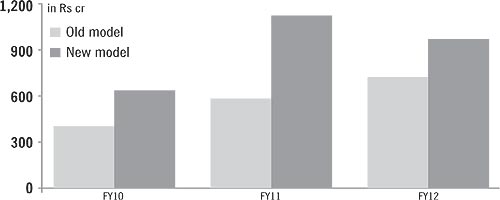
Source: CLSA Asia-Pacific Markets
***
Earlier this year, the stock took a severe beating on allegations that ranged from inflated profits, the diversion of funds via subsidiaries and inaccurate wage bills, to false debtor days and debt positions. Though the management managed to allay most of those fears, new concerns seem to have erupted. One is over the company’s deteriorating fundamentals as the company moves to smaller towns; realisation per student on its flagship multimedia product Smart Class (which accounts for 50 per cent of revenues and 60 per cent of profits) is likely to decline along with revenues per school. Educomp supplies multimedia course content across subjects, which is then shown as part of the class sessions. But a new securitisation arrangement and a change in accounting policy that recognises associated revenue upfront ensure that these declines do not show up in reported financials just yet. In fact, with the new accounting policy, analysts say that Educomp’s reported profits for 2011 would be higher by almost 80 per cent against those reported under the earlier method. Another growing concern is the fact that Educomp has stopped giving the debtor position every quarter. Analysts say that the accounting policy and business model changes have increased the complexity of the company’s financials. Another bad sign: the promoters have reduced their stake from 54.95 per cent in June this year to 50.21 per cent by September. That’s a significant reduction in stake over one quarter and investors could take a cue from the promoters.
Punj Llyod
- LTP (Rs): 196
- YTD returns (%): 33.5
- Promoter holding (%): 37.51
South-east Asia-pacifi c and Africa (including Libya) account for 62 per cent of the order-book
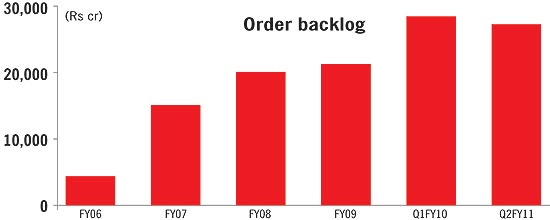
Source: Company data, Anagram research
***
The engineering and construction services company seems to be in a sweet spot given its Rs 26,800 crore order book – equivalent to 2.2 times its consolidated FY09 sales. But a look at its recent financial performance tells the real story. Cost overruns, client liability issues and poor revenue growth have pulled down sales 2 per cent and net profits by 63 per cent in the September quarter. What has got the analysts’ goat is that in the total order backlog, orders from south-east Asia-Pacific and Africa (including Libya) account for 62 per cent. Importantly, orders from Libya have yielded neither revenues nor profit margins in the September quarter. Besides, the company incurred cost overruns of Rs 104 crore in building a bio-ethanol plant for its client Ensus. Another concern is the mounting interest cost, despite having raised funds through a placement and non-convertible debenture issue. While the company, of late, has restructured its business to position itself as a parent with independent operating entities, one in South Asia and the other in West Asia, analysts do not see any upside from this move in the near term. The fact that the promoters have pared their holdings from around 54.8 per cent in FY06 to around 37.5 per cent as of September 2009 is not comforting either. Historically, the stock has traded at about a 35-40 per cent premium to Larsen & Toubro’s one-year forward P/E multiples on account of faster growth and improvement in execution – but not any longer. Analysts feel, going forward, PLL will continue to trade at a discount to L&T given the execution concerns and that the faster growth was due to a lower base and profitability.
Suzlon
- LTP (Rs): 84
- YTD returns (%): 35
- Promoter holding (%): 53.08
Despite recent debt restructuring, the overall gearing for the wind turbine maker continues to be high

***
It’s a story gone awry for the Pune-based wind turbine manufacturer. In an ambitious attempt to emerge as a global player, Suzlon made two acquisitions in Europe: one of gear box manufacturer Hansen Technologies in 2006 and the other of turbine manufacturer Repower in 2007. But post the financial crisis, which saw alternative energy investing losing steam, the string of pearls fast turned into a noose for the company. Though Suzlon has sold a 35 per cent stake in Hansen for $370 million and raised a five-year $465 million loan from the State Bank of India, analysts expect only a 14 per cent reduction in its net debt of Rs 12,500 crore at the parent level. Compounding the company’s financial woes is the bleak demand outlook. Analysts believe Suzlon is likely to miss the lower end of its FY10 shipment guidance of (1,900 mw). According to the management, the order book, as of October 30, 2009, stood at 1,489 mw, of which 123 mw was from India and 1,366 mw from overseas markets. Of the international orders, nearly 500 mw is likely to be shipped in the current fiscal and the balance in FY11. Given the difficult financing conditions faced by overseas customers and nil domestic orders, the outlook for Suzlon looks bearish in the near term. Further, the rapidly declining promoter holding in the company too is a cause for concern. From around 70 per cent in FY07, the Tanti (promoter) family’s stake has fallen in the current fiscal (up to September 2009) to 53 per cent, of which 43 per cent is pledged. At 70 times estimated current year earnings, the stock looks overly expensive.
Unitech
- LTP (Rs): 80
- YTD returns (%): 96
- Promoter holding (%): 43.84
Noida, Greater Noida and Kolkata account for 41 per cent of launches, but only 21 per cent of sales in current projects

***
The country’s second largest realty company by market capitalisation has managed a stellar 110 per cent outperformance against the Sensex since March even as it mopped up $900 million through institutional investors. But that’s where the feel-good factor ends. The bounce in the stock has not been ably matched by operational outpeformance. Of the 22 million square feet (msf) projects done in the past, Unitech delivered just 4.9 msf till September 2009 and proposes to deliver the balance 17 msf by March 2011. It proposes to deliver 10 msf of new projects by March 2012, making it a total of 27 msf in the next two and a half years. However, analysts believe that given Unitech’s past delivery schedule, execution will be a big challenge. More importantly, with 60 per cent of its projects located in weaker geographies, poor sales and low margins continue to pose a big risk. Currently, the company depends heavily on Noida, Greater Noida and Kolkata. While these markets account for 52 per cent of the total planned deliveries in the next couple of years, they account for around 60 per cent of projects yet to be sold. There are also no signs of any pick-up in high-margin verticals (high-end residential, office space, hospitality) in the near term, resulting in low revenue visibility. But the biggest negative is that the promoters have been cashing out of the company over the years. From holding 74 per cent in FY06, they had sold down their stake to around 44 per cent by the September quarter of this year. Compounding the weak outlook is the supply overhang from realty companies. Around 12 realty players are looking to collectively raise around Rs 19,000 crore (about 35 per cent of the current free float of the sector) in the near future. Against such a backdrop, investors need to sell into any sharp rally in the stock.










